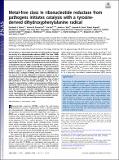| dc.contributor.author | Blaesi, Elizabeth J. | |
| dc.contributor.author | Palowitch, Gavin M. | |
| dc.contributor.author | Hu, Kai | |
| dc.contributor.author | Kim, Amelia J. | |
| dc.contributor.author | Rose, Hannah R. | |
| dc.contributor.author | Alapati, Rahul | |
| dc.contributor.author | Lougee, Marshall G. | |
| dc.contributor.author | Kim, Hee Jong | |
| dc.contributor.author | Taguchi, Alexander T | |
| dc.contributor.author | Tan, Kong Ooi | |
| dc.contributor.author | Laremore, Tatiana N. | |
| dc.contributor.author | Griffin, Robert Guy | |
| dc.contributor.author | Krebs, Carsten | |
| dc.contributor.author | Matthews, Megan L. | |
| dc.contributor.author | Silakov, Alexey | |
| dc.contributor.author | Bollinger, J. Martin | |
| dc.contributor.author | Allen, Benjamin D. | |
| dc.contributor.author | Boal, Amie K. | |
| dc.date.accessioned | 2020-06-17T20:36:29Z | |
| dc.date.available | 2020-06-17T20:36:29Z | |
| dc.date.issued | 2018-09 | |
| dc.date.submitted | 2018-07 | |
| dc.identifier.issn | 0027-8424 | |
| dc.identifier.issn | 1091-6490 | |
| dc.identifier.uri | https://hdl.handle.net/1721.1/125856 | |
| dc.description.abstract | All cells obtain 2′-deoxyribonucleotides for DNA synthesis through the activity of a ribonucleotide reductase (RNR). The class I RNRs found in humans and pathogenic bacteria differ in (i) use of Fe(II), Mn(II), or both for activation of the dinuclear-metallocofactor subunit, β; (ii) reaction of the reduced dimetal center with dioxygen or superoxide for this activation; (iii) requirement (or lack thereof) for a flavoprotein activase, NrdI, to provide the superoxide from O2; and (iv) use of either a stable tyrosyl radical or a high-valent dimetal cluster to initiate each turnover by oxidizing a cysteine residue in the α subunit to a radical (Cys•). The use of manganese by bacterial class I, subclass b-d RNRs, which contrasts with the exclusive use of iron by the eukaryotic Ia enzymes, appears to be a countermeasure of certain pathogens against iron deprivation imposed by their hosts. Here, we report a metal-free type of class I RNR (subclass e) from two human pathogens. The Cys• in its α subunit is generated by a stable, tyrosine-derived dihydroxyphenylalanine radical (DOPA•) in β. The three-electron oxidation producing DOPA• occurs in Escherichia coli only if the β is coexpressed with the NrdI activase encoded adjacently in the pathogen genome. The independence of this new RNR from transition metals, or the requirement for a single metal ion only transiently for activation, may afford the pathogens an even more potent countermeasure against transition metal-directed innate immunity. | en_US |
| dc.description.sponsorship | National Institutes of Health (Grant GM119707) | en_US |
| dc.language.iso | en | |
| dc.publisher | National Academy of Sciences | en_US |
| dc.relation.isversionof | http://dx.doi.org/10.1073/pnas.1811993115 | en_US |
| dc.rights | Article is made available in accordance with the publisher's policy and may be subject to US copyright law. Please refer to the publisher's site for terms of use. | en_US |
| dc.source | PNAS | en_US |
| dc.title | Metal-free class Ie ribonucleotide reductase from pathogens initiates catalysis with a tyrosine-derived dihydroxyphenylalanine radical | en_US |
| dc.type | Article | en_US |
| dc.identifier.citation | Blaesi, Elizabeth J. et al. "Metal-free class Ie ribonucleotide reductase from pathogens initiates catalysis with a tyrosine-derived dihydroxyphenylalanine radical." Proceedings of the National Academy of Sciences 115, 40 (September 2018): 10022-10027 © 2018 National Academy of Sciences | en_US |
| dc.contributor.department | Massachusetts Institute of Technology. Department of Chemistry | en_US |
| dc.contributor.department | Francis Bitter Magnet Laboratory (Massachusetts Institute of Technology) | en_US |
| dc.relation.journal | Proceedings of the National Academy of Sciences | en_US |
| dc.eprint.version | Final published version | en_US |
| dc.type.uri | http://purl.org/eprint/type/JournalArticle | en_US |
| eprint.status | http://purl.org/eprint/status/PeerReviewed | en_US |
| dc.date.updated | 2019-12-18T13:45:33Z | |
| dspace.date.submission | 2019-12-18T13:45:35Z | |
| mit.journal.volume | 115 | en_US |
| mit.journal.issue | 40 | en_US |
| mit.metadata.status | Complete | |
